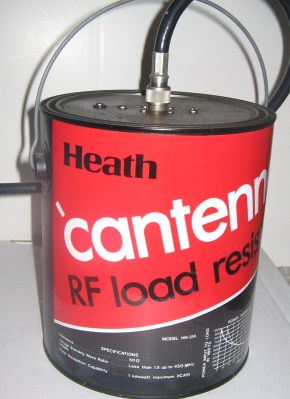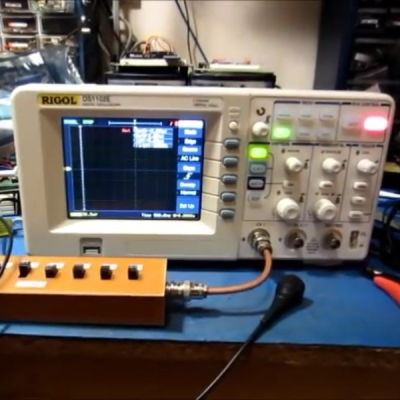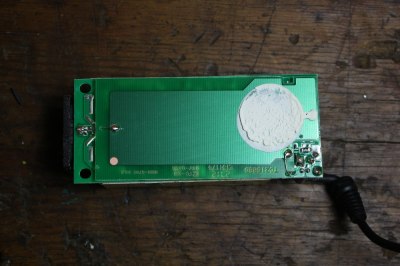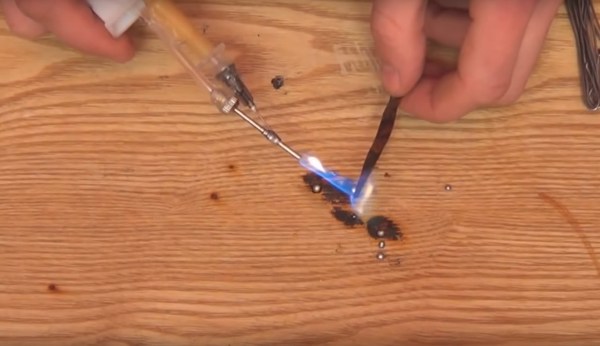By 2016, most people have got the hang of doing SMD soldering in the garage–at least for standard packaging. Ball Grid Array or BGA, however, remains one of the more difficult packages to work with [Colin O’Flynn] has an excellent video (almost 30-minutes, including some parts that are sped up) that shows exactly how he does a board with BGA.
Tool Hacks3031 Articles
DIY Mini Butane Torch Would Make MacGyver Proud
Need to MacGyver yourself out of a situation with a mini torch? Well, you might want to watch this video of how to make a mini butane torch out of some random household components.
Built by [Roman UrsuHack], almost all the parts in this assembly are being used completely not as manufacturer intended. Which is why we love it. And why it’s a bit dangerous too.
Using an inkjet printer cartridge refill syringe, a bicycle pump needle, some tubing, a few compression valves (they look almost like medical equipment, for blood donation), a water bottle, a can of butane, lots of hot glue, and a few bicycle pump fittings, [Roman] has created a rather ingenious little butane torch.
Continue reading “DIY Mini Butane Torch Would Make MacGyver Proud”
Desoldering Doesn’t Necessarily Suck
What’s your favorite way to fix soldering mistakes or get usable components off that board you found in a Dumpster? I’ve always been partial to desoldering braid, though I’ve started to come around on the vacuum pump depending on the situation. [Proto G] sent in an Instructable that outlines nine different ways to desolder components that take varying amounts of time and skill.
He starts with one that is often overlooked if you don’t have a solder pot. [Proto G] recommends this method only when you don’t want to keep the board. Cover the solder joints of the components you want to keep with flux and hold it over the solder pot while pulling out the components with pliers. The flux isn’t critical, but it makes removal faster and easier.
For boards in need of repair, [Proto G] uses a manual pump or copper desoldering braid that comes coated with flux. If you can afford one, a desoldering machine seems like the way to go—it combines the heat of a soldering iron with the vacuum of a manual pump. Desoldering tweezers and hot air rework stations look like great ways to remove surface mount components.
If you enjoyed this, check out [Bil Herd’s] guide on component desoldering. There are also few ways that [Proto G] doesn’t mention, like holding the board over an alcohol flame. Let us know your favorite desoldering method in the comments.
Little Helper: Open Source Hardware Hacker Multitool
We love a good multitool. There’s something seductive about knowing that if, for some reason, you need to saw down a tree on a moment’s notice, you have a tiny saw in your pocket. We also like electronic versions of the multitool: gadgets that serve a lot of purposes as you develop and debug hardware. One of the most polished-looking ones we’ve seen is [Phillip Schuster’s] Little Helper.
The open source gadget looks like an iPod (if an iPod had header pins sticking out of it). It has basic analog I/O capability, can generate PWM pulses, sniff I2C traffic, and do lots of other features. It is open source, so you can always add more capabilities if you need them.
Continue reading “Little Helper: Open Source Hardware Hacker Multitool”
You Can Learn A Lot From A Dummy (Load)
If you work on RF circuits–even if you aren’t a ham radio operator–you ought to have a dummy load. A dummy load is a non-radiative “antenna” with known impedance that you can use to test your RF circuit without radiating. For radio work, you usually just need a 50-ohm resistor that is non-inductive (at least at the frequencies you are interested in) and that can dissipate the amount of power you’ll expect it to handle (at least for a short time). [VO1PWF] wanted a dummy load and built his own.
 The Cantenna (not the Pringle’s kind; see right) was a famous dummy load design when Heathkit was in business. It was a single carbon rod immersed in a paint can full transformer oil (which we now know was full of dangerous PCBs; and we don’t mean printed circuit boards). [VO1PWF’s] design is a little more practical, using some resistors in parallel (20 1K resistors), a plastic pipe housing, and mineral oil to keep it all cool.
The Cantenna (not the Pringle’s kind; see right) was a famous dummy load design when Heathkit was in business. It was a single carbon rod immersed in a paint can full transformer oil (which we now know was full of dangerous PCBs; and we don’t mean printed circuit boards). [VO1PWF’s] design is a little more practical, using some resistors in parallel (20 1K resistors), a plastic pipe housing, and mineral oil to keep it all cool.
The reason for the parallel resistors is to maximize the power handling capability. The resistors are 3W units, so the dummy load–in theory–can handle 60 watts. Often, high power resistors are wire wound and thus have a good bit of parasitic inductance that makes the dummy load reactive (not a good thing since that makes the load impedance vary by frequency). They do make non-inductive wire wound resistors, but these aren’t truly non-inductive. The wire winds in two different directions, so the inductance tends to cancel out. We wouldn’t trust them to be a pure resistance in a high-power dummy load design.
No Spectrum Analyser? No Problem!
In the Bad Old Days, a spectrum analyser was a big piece of expensive machinery that you’d have on your bench next to your oscilloscope. And while good ones still cost a ton of money, [rheslip] shows you how to turn your VISA-compatible scope into a decent spectrum analyser for the low, low price of nothing. Watch it in action in the video below the break.
 If your scope is relatively recent, like this side of the late 1990s, it might support National Instrument’s VISA: virtual instrument software architecture. [rheslip]’s Rigol scope does, and he uses PyVisa, a Python wrapper for the NI-VISA libraries to download the raw samples from the ‘scope and then crunches the FFTs out on his laptop.
If your scope is relatively recent, like this side of the late 1990s, it might support National Instrument’s VISA: virtual instrument software architecture. [rheslip]’s Rigol scope does, and he uses PyVisa, a Python wrapper for the NI-VISA libraries to download the raw samples from the ‘scope and then crunches the FFTs out on his laptop.
There are definitely drawbacks to this method. The sampling depth of the scope is eight bits, which limits his maximum signal-to-noise ratio, and the number-crunching and data transfer are slow, resulting in a 2 Hz refresh rate. But once the data has made it across to his laptop, [rheslip] can run the FFTs at whatever sample length he wants, resulting in very high frequency resolution.
Indeed, we’re thinking that there’s all sorts of custom filters and analysis that one could do with raw access to the oscilloscope’s data. Why haven’t we been doing this all along? Any of you out there have cool VISA tricks that you’d like to share?
Sparkfun Tears Apart Power Supplies
We love a good tear-down, and last week’s “Enginursday” at Sparkfun satisfied our desire to see the insides of AC-DC switching power supplies, accompanied by knowledgeable commentary. [MTaylor] walks us through how the basic circuit works and then points out why various other elaborations are made, and how corners are sometimes cut, in a few power supplies that he’s taken apart.
 What struck us in the comparison was that some of the power supplies were very minimal designs, while others had “features” that were obviously added after the fact. For instance, the Li Shin supply (about half-way down the page) has an extra circuit board tacked on to the bottom of the real circuit board to act as EM shielding.
What struck us in the comparison was that some of the power supplies were very minimal designs, while others had “features” that were obviously added after the fact. For instance, the Li Shin supply (about half-way down the page) has an extra circuit board tacked on to the bottom of the real circuit board to act as EM shielding.
Rather than declare this a dodgy hack, as we would have, [MTaylor] declares it to be “Good News!” because it means that they’ve probably run an emissions test, failed it, and then added this bit on to make it pass. This is of course in contrast to the other makers who’ve probably never even considered emissions testing. Sigh.
If you’re interested in seeing more inner bits of power bricks, Sparkfun forum reader [sgrace] passed along this field guide to various power supplies, which is also worth a look. And if you’re interested in building yourself the ultimate bench power supply, look no further than this Hackaday.io project by [The Big One].

















